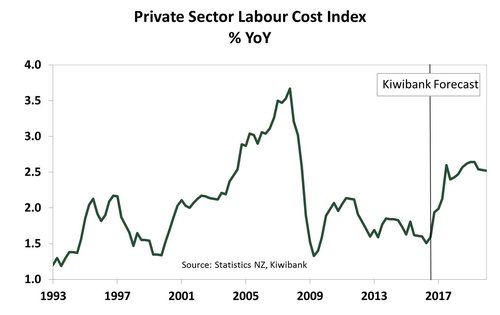The new Government has wasted no time in launching into its policy agenda and in its speech on 8 November set out an ambitious 100-day plan. A number of policies outlined in the 100 day plan are likely to affect businesses, but we focus on proposed increases to the minimum in this note. From 1 April 2018 NZ’s adult minimum wage will be lifted to $16.50/hr from the current rate of $15.75/hr. The Government has also announced that it intends to steadily raise the minimum wage to $20/hr by 1 April 2021. The proposed pace of minimum wage increases is much faster than the hikes experienced under the National-led governments of 2008-2017. Between April 2008 and April 2017 the adult minimum wage experienced average annual increases of just over 3%. In contrast, the current Government’s proposed increases would see an average annual rise in the minimum wage at twice that pace through to 2021 – around 6.2% yoy. Lifting the minimum wage is seen as a way to improve the lot of those at the bottom end of the pay scale, especially for those living in places with significant costs of living such as Auckland. However, a rising minimum wage also represents an increase in costs for businesses. These cost increases are particularly acute for firms within industries that hire a large share of lower skilled workers such as retailing and hospitality. As a result, we see the upcoming minimum wage increases adding to already rising labour costs and inflation.
The impact on the economy from changes to the minimum wage is a contentious area. We expect the proposed hikes to the minimum wage to have a measurable impact on wage and general price inflation in the coming years as firms pass higher costs on to customers. The Ministry of Business, Innovation and Employment’s (MBIE) minimum wage review in 2016 noted that around 73,000 NZ workers received the minimum wage in 2016, which represents 2.9% of the total workforce. While a rise in the minimum wage will increase wages for those roughly 73,000 workers, there are also indirect wage increases for those currently being paid just above the minimum wage as they may argue to have their pay rates kept in lockstep with the minimum wage. Wage inflation showed some signs of life in the September quarter, with the private sector Labour Cost Index (LCI) – a measure of pure wage inflation – lifting 1.9% yoy from 1.6% yoy in the middle of the year. However, the recent rise in wage inflation was largely due to a pay-equity deal for care and support workers that came into effect on 1 July 2017. We are anticipating that wage inflation will gather pace over 2018, in part due to the planed hike to the minimum wage, but also as growing capacity pressures and labour shortages experienced by many industries (such as construction) gain momentum. We are forecasting that minimum wage increases will add between 0.4-0.6 percentage points to annual LCI wage inflation over the coming years and see wage inflation reach 2.5% by mid-2018 (see chart below). As a result, we see general inflation increasing at a faster pace than forecast by the RBNZ at the November Monetary Policy Statement (MPS), leading to the RBNZ gradually hiking the official cash rate (OCR) from late 2018 – around six month earlier than the Bank signalled at the November MPS.

The other notable effect of a minimum wage rise is a fall in employment as businesses respond to the higher cost of labour by substituting towards capital over the medium term. MBIE’s 2016 report noted only a modest 7,000 decline in employment if the minimum wage rose to $16.50/hr – although this was from a lower starting point of $15.25/hr in 2016. In the same report a rise in the minimum wage closer to $20/hr was seen as translating into a much larger fall in employment – 28,000.
For some businesses the upcoming rise in the minimum wage will pose an added challenge and will need to be factored into staffing budgets over the coming years. The scale of these minimum wage hikes are likely to see demand for pay rises from those currently receiving a wage just above the minimum. However, as pointed out above minimum wage increases is one of a number of factors that are expected to contribute to rising wages – such as ongoing capacity constraints.
